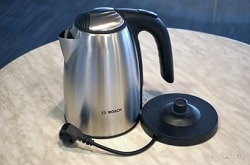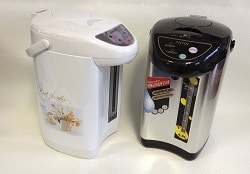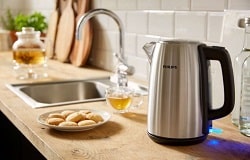What is better and more economical than a thermopot or an electric kettle? Device features
Household appliances have become an integral part of modern life. It is hard to imagine a kitchen without an electric kettle that heats water much faster than usual. But the development of household appliances does not stand still.
Electric kettle in the kitchens appeared a long time ago, but thermo sweat recently.
But what is safer and more economical to use? What are the pros and cons of both of these devices and which is better? Let's try to figure this out.
Pros and cons of an electric kettle
Advantages:
- A standard kettle can boil 2 liters of water in 1 minute;
- Compact and handy size;
Large selection of models of different sizes, highlights and shapes;
- Affordable prices on the market;
- Stylish high-tech design.
Flaws:
- Often the volumes do not reach more than five liters;
- At the moment of boiling, a lot of electricity is expended;
- Cheap models leak and often fail.
Pros and cons of thermopots
Advantages device data:
- Not only boil water, but also keep it hot for a long time;
- Large capacity up to 8 liters;
- Moderate electricity consumption;
Some models have the function of heating water at a certain time;
- Convenient use - no need to lift the device, just bring the cup to the spout and press the corresponding button.
Minuses thermopots:
- Bulky dimensions;
- High cost, unlike teapots;
- Sustained boiling speed.
Device features
Before drawing conclusions that it is more profitable for you to purchase, you need to compare both devices according to other characteristics.
| Electric kettle | Thermopot |
| Principle of operation: The device consists of the following components:
In order for the water to boil in it, the current is supplied to the contacts of the stand, then it goes to the thermostat, then to the heating element.
| Principle of operation: This device combines the properties of a cooler, a thermos and a cooler. The main difference from an electric kettle is that it keeps the temperature in the range from 70 to 80 degrees for a long time. What is the operation of the device:
|
| The amount of energy consumed: Directly depends on the model.
Modern models come in three types of power - 2000 W, 2200 W, 2400 W. If we take an average of 2100 watts, then in one hour he will spend 2.1 kV. REFERENCE! It is more economical to turn on the kettle at full capacity. The device gives off part of the heat to the lid and body, the faster it heats up, the less energy is needed for boiling. | The amount of energy consumed: We take average indicators as a basis - power 800W, volume 4 liters and boiling time 12 minutes.
In the keep warm mode, the device can work for 10 hours and keep the temperature at 90 degrees. The average energy consumption for maintenance is 30 watts. A kW per month is 13.8. REFERENCE! Savings with a kettle will be approximately 1.2 kW, which is not significant at all. |
| Volumes and power: Teapots cannot boast of a large capacity - the maximum you can find is up to 4 and 5 liters.
Power from 2000W to 2400W. | Volumes and power: Thermal pots are designed for large volumes.
Models start from 5 to 8 liters. Power varies from 800W to 1600W. |
| Design differences: The kettle only heats water, the body is usually made of plastic or metal.
Buttons and levers are also plastic. | Design differences:The body of the product is glass, ceramic, plastic and metal.
The inner flask is removable, made of stainless steel with thick walls. |
| Functional Features: Not the cheapest models have the following set of functions - timer to turn on, clock, heating, thermoregulation, child lock. | Functional features: scalding protection, portion regulation, water purification level indicator, additional reservoir.
|
| Purpose of operation: This is more of a family appliance, designed to be used by three or four people.
Suitable for those who do not want to wait a long time for the kettle to boil, who do not have too small children who can get burned. Also, for owners of a small kitchen, a compact kettle is better than a bulky thermo pot. | Goals of operation: For those who need constant warm water at hand, for a large family or a small office.
May be needed for the preparation of infant formula, brewing teas from various varieties.
|
Buying advice:
- Still, electric kettles are suitable for most household purposes;
- For a small kitchen, a thermopot is not the best solution., because it will look bulky and inappropriate;
- Fans of functional technology would be more rational to purchase an electric kettle;
If there is no need to constantly rearrange or transport the device, then you can purchase a thermal pot;
- If different regulation of temperature and degree of heating is important, then your choice is obvious;
- The average cost of paying for the energy consumed by an electric kettle is 162 rubles, a thermopot is 89 rubles.
- If you do not need access to constant boiling water, then it will be more convenient to buy a kettle;
- Thermopots are perfect for mass events, assuming the presence of a large number of people, and if you are going, for example, to the country house, then it will be more economical and more comfortable to take an ordinary electric kettle.
Useful video
From this video you will learn what is better and more profitable to buy, a kettle or a thermopot:

conclusions
Summing up, it can be noted:
- Kettles are convenient due to their small size, the speed of water heating to the state of boiling water, the price also does not bite.
For a small family, for a small work team, for summer cottages - in these cases they are most appropriate. - Thermo pots are more suitable for production scale, that is, for large meetings, for use in offices, coffee shops, perhaps even bars or kindergartens.
In this regard, the device is safe, the risk of scalding is minimal. - It is not excluded the possibility of using thermo pots by families with many children or mothers of babies, for whom it is important to keep the mixture and other food for a child at a certain temperature.
- Thermopot is not economical if it is used only a couple of times a day.

 Large selection of models of different sizes, highlights and shapes;
Large selection of models of different sizes, highlights and shapes; Some models have the function of heating water at a certain time;
Some models have the function of heating water at a certain time; If there is no need to constantly rearrange or transport the device, then you can purchase a thermal pot;
If there is no need to constantly rearrange or transport the device, then you can purchase a thermal pot;
I had both thermo pots and kettles. I like the thermopot better. There is always hot water, but you have to wait for the kettle. Plus, more scale forms in the kettle than in the thermopot. But that's what teapots, that thermal pots fail after a while. Although the thermopots served us longer, we had two of them. They didn’t look cumbersome in the kitchen, they stand in a corner and make themselves happy) the teapots were also different, but something recently began to break down quickly, one before the end of the guarantee, the other a little after. And yet - some kettles stink of plastic for a while. Well, that is, this stench is transferred to water, and drinking "plastic" tea is not a very pleasant experience, but hardly useful. At the moment we don't have a thermopot or a kettle. The third kettle in a row is dead (We use an old grandmother's coffee pot for some time. Although it boils for a long time, it does not have scale, stink, and in general will work for another hundred years. We still plan to buy a good thermal pot.
Choosing between a thermopot and an electric kettle, I will give preference to a kettle.Firstly, it is more beneficial to drink tea warmed up only once! Secondly, our family chooses a glass teapot to avoid the taste of plastic.